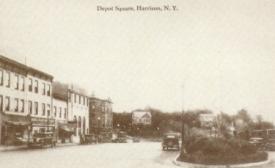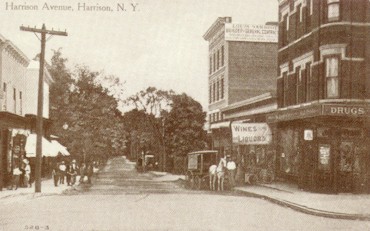Downtown Harrison
 While Harrison's Purchase and Silver Lake saw early settlement, Harrison's downtown section did not develop until after the coming of the railroad in 1848.
While Harrison's Purchase and Silver Lake saw early settlement, Harrison's downtown section did not develop until after the coming of the railroad in 1848.
In the beginning, people had to flag down the train to get aboard, be after the station was built in 1870 and it became more comfortable to commute, the opening of the railroad in this fashion dramatically changed the character and center of activity in Harrison. Although there were farms in the southern end of town, wealthy business people from New York City bought the land for their country homes and many large estates were developed.
The station was actually erected and given to the town by William Matthews, who owned property in the area. He also built a large hotel called the Mansion House at the corner of Halstead and Purdy Avenue, as the railroad would not permit a Station House in town unless there was a hotel to accommodate passengers. The Mansion House, later known as the Harrison Hotel, is now the location of the Dime Savings Bank.
One lovely residential area that was established was on Sunnyridge Farm, purchased in 1853 by Josiah Macy, a retired sea captain, whose home stood on North Street from which elevation he claimed he could see all the way to the Sound. "...When evening comes, I have the cheerful view of the lights from five lighthouses which are placed there to guide the mariner on his way...Since I left business in New York, I have passed most of my time on my farm; the quiet rural retirement has been very congenial to my feelings; it is what I often thought of in years that are gone..."
This beautiful 165 acre estate was later sub-divided and sold and is now the Sunnyridge section we know today with its many attractive streets and homes.
 Harrison was developing in another way as well for the railroad brought in many Italian immigrants who bought plots to farm in Brentwood and Silver Lake. Today their descendants are part of the strength of our diverse community, as gradually there evolved the distinctive neighborhoods of Harrison and West Harrison that make up our unique town/village.
Harrison was developing in another way as well for the railroad brought in many Italian immigrants who bought plots to farm in Brentwood and Silver Lake. Today their descendants are part of the strength of our diverse community, as gradually there evolved the distinctive neighborhoods of Harrison and West Harrison that make up our unique town/village.
In the first U.S. Census Report of the year 1790, the Township of Harrison was listed as having a population of 1,156, including 54 slaves. In 1880, it had increased to only 1,494.
The town has retained its rural character to a greater degree than some of the other communities within a comparable distance from New York.
On March 7, 1788, New York passed legislation which divided its counties into towns numbering more than 100. "...and that all that part of said County of Westchester called and known by the name of Harrison's Purchase, shall be and hereby is erected into a town, by the name of Harrison."
A real estate brochure of 1906 stated "Harrison is a good place to live. There are over 50 trains daily between Harrison and New York City with a commutation of 10 cents a trip." It was known as the New York, Westchester and Boston Railroad. Since 1927, when it became the New Haven Line, it has changed little, and is said to have been more efficient then!
Access by road improved when the Hutchinson River Parkway reached Harrison in 1929. Few know that 60 years ago, another parkway was planned which would extend from White Plains to Port Chester along the present day route of Westchester Avenue. Land was sold and many houses were built by enthusiastic developers, but the plan was never completed. Today, Parkway Knolls extends from Westchester Avenue north two blocks to Parkview Avenue, and between Underhill Avenue and Croker's Pond, also known as Spring Lake.
The Harrison Historical Society has its home in West Harrison on the corner of Lake Street and Park Lane in the Charles Dawson History Center. The site is the location of a one room school house known as District No. 5 which was originally established further up Park Lane in 1817.
